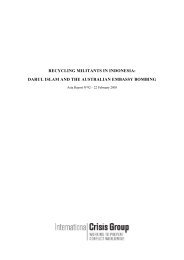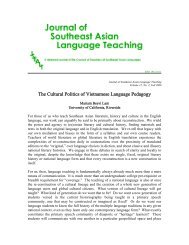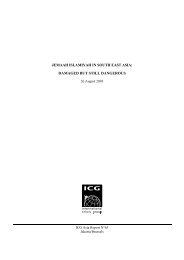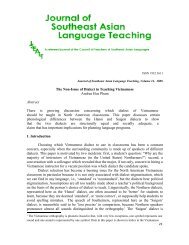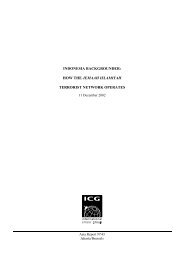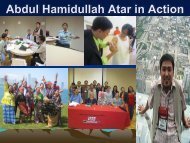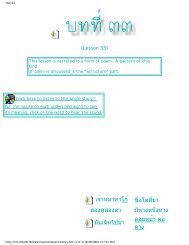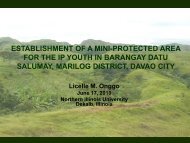Introduction - SEAsite - Northern Illinois University
Introduction - SEAsite - Northern Illinois University
Introduction - SEAsite - Northern Illinois University
Create successful ePaper yourself
Turn your PDF publications into a flip-book with our unique Google optimized e-Paper software.
Prentation Abstracts<br />
with no existing resources and infrastructure. The following are major points for<br />
both the opportunities and challenges for the business people to consider.<br />
Opportunities:<br />
• US is biggest world economy<br />
• 500,000 strong Laotian-Americans<br />
• US serves as a sources for funding, professional skills and technologies<br />
to Laos<br />
• Existing and emerging Lao-American entrepreneurship<br />
• Lao-American investments in Laos<br />
• Young Laotian-American professionals and entrepreneurs<br />
Challenges:<br />
• New comer and has to compete with the existing network of other Asian<br />
businesses<br />
• Political factionalism of Laotian-Americans in the United States<br />
• Quality of goods and products from Laos and the price<br />
• Business ethic and professionalism of Lao business people in Laos<br />
• Transportation<br />
• Banking<br />
• Insurance<br />
• Distribution channel of goods through out the US<br />
Recommendations:<br />
• Creation of national network of Laotian-American businesses who are interested<br />
to engage in US-Laos trade and investment opportunities. (US-<br />
Laos Trade and Investment Group) to promote the trading and investment<br />
opportunities and address the emerging issues.<br />
• Organize the conference and seminars to attract the mainstream American<br />
corporations and businesses to invest and trade with Laos.<br />
Shoua Thao* and Kristin Espinosa** listed but only Thao<br />
Hmong in Wisconsin: Attitudes toward Minnesota’s Hmong<br />
Marriage Bill<br />
*McNair Scholar, <strong>University</strong> of Wisconsin-Milwaukee<br />
**Professor Sociology, <strong>University</strong> of Wisconsin-Milwaukee<br />
Wisconsin, USA<br />
“Mai Xiong died while riding as a passenger in a car driven by her husband,<br />
Nhia Xiong. Mai’s and Nhia’s minor children...filed a variety of claims against<br />
Nhia, including a wrongful death claim. The trial court, however, determined that<br />
the wrongful death claim belonged to Nhia, not his children, and therefore dismissed<br />
it. As the “surviving spouse,” Nhia was first in the line of priorities as<br />
provided by [Wisconsin statute]. The minor children contended that their parents’<br />
marriage was invalid and thus their wrongful death claim should be reinstated.”<br />
(Blinka and Hammer, 2002)<br />
A young pregnant Hmong woman married her boyfriend, the father of her<br />
child, in a traditional Hmong marriage. They later divorced, and now with two<br />
children, she cannot claim child support or any marital benefits in the U.S. court,<br />
because there is no legal documentation of the marriage (Heng, 2004).<br />
These are two examples of the consequences of marriage in the Hmong<br />
tradition, which is not legally recognized by U.S. law, whether the marriage took<br />
place before or after arrival in the United States. To prevent such complications,<br />
Minnesota State Representative Andy Dawkins proposed a bill in 1991 in the Minnesota<br />
state legislature that would legalize the status of marriages conducted in the<br />
Hmong tradition. This bill, the Hmong Marriage Bill (HMB), was intended to help<br />
legalize, prevent, and clarify Hmong marriages in order to prevent further legal<br />
problems such as child support, insurance, and specifically taxes. It would alleviate<br />
certain legal disadvantages, but it would also significantly alter crucial aspects<br />
of the Hmong marriage tradition.<br />
In this study, I surveyed individuals in the Hmong community in Wisconsin<br />
(Milwaukee and Green Bay) to analyze their perspectives on Hmong traditional<br />
marriage and, more specifically, the HMB. I evaluated the attitudes of people in<br />
the Hmong community, focusing on whether and how demographic factors, such<br />
as education, gender, and age, influence those attitudes toward the HMB. In addition,<br />
I conducted unstructured interviews with Hmong community leaders and<br />
elders. The purpose of this research is to explore how Hmong’s perception on<br />
traditional marriage and practices might have potential affects on attitudes toward<br />
the HMB.<br />
Hongvilay Thongsamouth<br />
Lao-America and the Laws That Shape It<br />
Gokhokho Publishing, Inc., California<br />
Before 1975, only about 500 Lao* had been admitted into the United States.<br />
Today, almost 400,000 individuals from Laos reside in the United States as lawful<br />
permanent residents and citizens.<br />
The mass exodus following the American withdrawal from the Vietnam conflict<br />
forced the United States to develop extensive refugee resettlement laws and<br />
policies. These policies, in turn, have largely shaped the formation and character<br />
of the Lao-American community as it exists today.<br />
From early resettlement policies to current laws affecting detention and the<br />
threat of possible deportation, this presentation seeks to explore the history of Lao-<br />
American immigration and the specific laws that have shaped and that continue to<br />
shape the community.<br />
*Lao in this paper refers to all ethnic groups from Laos (e.g. Hmong, Mien,<br />
Khamu, Tai Lue, Tai Dam, etc.)<br />
Susada Viravong<br />
The Image of Women in the Sex Trade<br />
Washington<br />
An old profession, a modern problem in today’s society is prostitution.<br />
Women in the sex industry are on the rise no matter how much effort we try to<br />
control the problem. This is the result of modernization where people’s desire<br />
(tanha) for money and material things are on the rise.<br />
Whether that these women are willing or not, society’s view of them and<br />
their profession is still seen as negative. These women cannot face people in society<br />
because even money can buy their body and their integrity, reducing their<br />
worth. Now, these women’s old profession is no longer taboo, instead, their profession<br />
is more visible and out in the open for society to see and buy their service.<br />
The above concept influences the painter’s creativity studies and researches<br />
on prostitution. From painting and researching the theme of Women in the Sex<br />
Industry, which the paintings capture real life problem, the painter would like her<br />
work to act as a social criticism towards our apathetic society. The painter also<br />
wishes that her work will educate society about the problem of prostitution and<br />
hope that her work will motivate other potential artists and researchers to use her<br />
work to further their studies about prostitution as a theme for their artwork.<br />
Prayut Wannaudom<br />
The Cultural Collision between folk Performing Arts<br />
“Molam” and Culture Industry<br />
Ph.D candidate of Faculty of Communication Arts, Chulalongkorn <strong>University</strong>,<br />
Thailand<br />
In the past , Molam is a form of folk performance of the north-eastern region<br />
of Thailand. It was performed in special occasions such as in a traditional ritual or<br />
ceremony. At present, due to the more advance technology in mass communication,<br />
Molam is more popular. This is because mass communication, which is the<br />
Culture Industry acts as media through which Molam can reach various audiences.<br />
Mass communications play significant roles in producing more Molam and transforming<br />
Molam into a modern performance.<br />
Finally, Molam is promoted to be global performance because it is managed<br />
to be cultural commodity by mass communication. Many entertainment enterprises<br />
and industries bring efficient management system to serve every process of the<br />
production of Molam, for example, Molam becomes live show recorded in to the<br />
VCD format, tape cassette, audio CD, VCD karaoke for mass distribution into the<br />
market.<br />
Nowadays, we can witness the cultural effects of the phenomenon of Molam<br />
as Global performance as follows:<br />
1. The more Culture Industry exercise its roles in society, the more Molam<br />
displays its unique identity because Culture Industry contributes in distinguishing<br />
the differences between global performance and local performance. As a result, we<br />
can better perceive the differences of these two forms of performance.<br />
2. When the rise of Culture Industry brings the Western performance to<br />
Thailand, there is the resistance from conservative Molam artists. Especially the<br />
traditional Molam artists try to maintain their identity by negotiating with the







